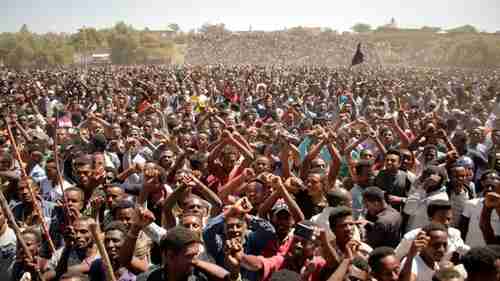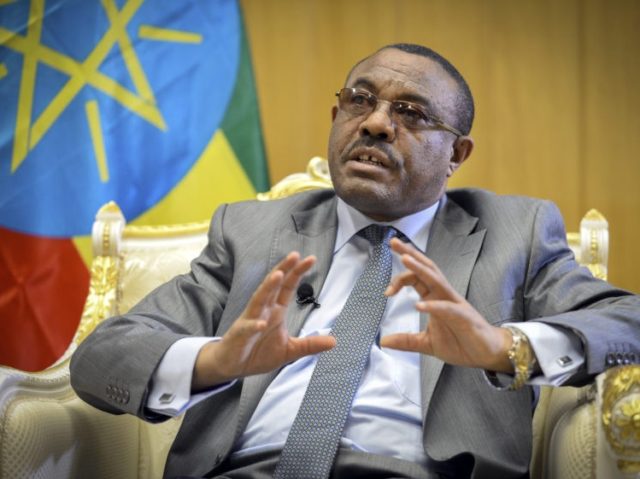This morning’s key headlines from GenerationalDynamics.com
- Ethiopia declares state of emergency after shock resignation of prime minister
- Generational analysis of Ethiopia’s protests and state of emergency
Ethiopia declares state of emergency after shock resignation of prime minister

Massive protests in Ethiopia’s Oromia region pushed prime minister Hailemariam Desalegn to resign (Reuters)
Ethiopians on Thursday were shocked and surprised when the country’s prime minister Hailemariam Desalegn submitted his letter of resignation, after being in office since 2012. In a televised address, he said:
Unrest and a political crisis have led to the loss of lives and displacement of many. I see my resignation as vital in the bid to carry out reforms that would lead to sustainable peace and democracy.
The unrest and political crisis he’s referring to is anti-government protests by millions of people, especially among the marginalized Oromo ethnic group, which comprises 34 percent of Ethiopia’s population, and among the Amhara ethnic group, which comprises another 27 percent.
Since 1991, the government has been largely controlled by the ethnic Tigrayans, who are a market and government dominant minority, comprising only 6 percent of the population. Hailemariam Desalegn was a member of the tiny Wollayta ethnic group, party of the Tigrayan ruling coalition.
Hailemariam’s resignation was apparently an attempt to calm the protests. But as it failed to do so, the Council of Ministers declared a state of emergency that “would be instrumental in thwarting ethnic-based conflicts in the country and safeguarding the constitutional order.”
The details of the state of emergency were not revealed, except to say that it would be similar to the last state of emergency, which began in October 2016, and ended only a few months ago in August 2017. According to Human Rights Watch’s description of the last state of emergency:
The government’s emergency powers brought mass detentions, politically motivated criminal charges, and numerous restrictions on people’s movement and communication. While the end is welcome news, thousands remain in detention without charge, none of the protesters’ underlying grievances have been addressed, and politically motivated trials of key opposition leaders, artists, journalists, and others continue.
There are concerns that the new state of emergency will only repeat the abuses of the last one. Ethiopian News Agency and Addis Standard (Addis Ababa) and Bloomberg and Reuters and Addis Standard and Reuters
Generational analysis of Ethiopia’s protests and state of emergency
What we are seeing here is a variation of a pattern that I have described repeatedly in several countries. This pattern occurs in the aftermath of a generational crisis war when, rather than being an external war with another country, the war is a civil war within the country between tribes and ethnic groups. Such a war is generally between two tribes or ethnic groups who have been neighbors for decades, who intermarried, and whose children played together, but then suddenly they turn on each other and commit atrocities, rapes, murders, torture, mutilations, and massacres on their former neighbors, including women and children.
That kind of war traumatizes both the winners and the losers. The new country leader, usually from the winning tribe, is someone who had directed or approved these atrocities, rapes, and massacres, and in his mind considers them to have been completely justified. The civil war always ends with some sort of agreement that all the warring ethnic groups will suddenly love one another live together in peace and harmony. But in practice, in the decades that follow, the losing tribe is marginalized, and in the following generational Awakening era, begins to protest. The country leader believes that a new civil war is beginning, and returns to the atrocities of the civil war in order to prevent a new war from occurring. Examples that I have reported on include Paul Biya in Cameroon, Pierre Nkurunziza in Burundi, Paul Kagame in Rwanda, Yoweri Museveni in Uganda, Robert Mugabe in Zimbabwe, Joseph Kabila in DRC, or, outside of Africa, Bashar al-Assad in Syria and Hun Sen in Cambodia.
Ethiopia’s last generational crisis war occurred in 1991, when the Marxist Derg dictatorship was overthrown. A Tigrayan war leader, Meles Zenawi, was in power until his death in 2012. Although the Tigrayans comprise only 6 percent of the population, the Tigrayan governing coalition increasingly marginalized the two largest ethnic groups, the Oromo ethnic group (34 percent of Ethiopia’s population), and among the Amhara ethnic group (27 percent).
In 2012, Hailemariam Dessalegn, from a small ethnic group (Wollayta) became prime minister. It was hoped that Hailemariam would institute reforms that would improve the lives of the Oromos and the Amharas, but Hailemariam was still part of the Tigrayan governing coaliation and followed the same policies. The reforms that had been promised were not implemented, and the situation was made worse by a severe drought.
There were massive anti-government protests by the Oromos and the Amharas, resulting in a brutal state of emergency that ran from October 2016 to August 2017. With minor changes, this is exactly the pattern that I’ve repeatedly described in the other countries listed above.
After the state of emergency ended in August 2017, nothing had changed. Reforms that had been promised did not occur. Once again, there were massive protests by the Oromos and Amharas. In an attempt to quell the protests last month, the government announced the release of hundreds of political prisoners from the last state of emergency and promised further reforms.
Those measures did not reduce the protests, and Hailemariam resigned on Thursday, saying, “I see my resignation as vital in the bid to carry out reforms that would lead to sustainable peace and democracy.” Apparently, Hailemariam was no longer willing to play the role of useful idiot and serve as cover for the same Tigrayan policies that had been in place since 1991.
Now Ethiopia is at a new tipping point. A new prime minister will have to be chosen. Surprisingly, some analysts are saying that the leading candidate for prime minister is articulate, charismatic and confident 47-year-old Lemma Megersa, from the Oromo ethnic group. Once again, hopes are rising that needed reforms could finally be implemented, if an Oromo became prime minister.
Such hopes are probably misplaced. Lemma may be an Oromo, but he has also been part of the official “establishment” for his entire political career since the 1990s, and even if he is chosen as PM, it is unlikely that he will be able to effect any real changes. Whatever generational forces have brought about the current set of policies, those generational forces will not change because of one person becoming prime minister. Addis Standard (Addis Ababa) and Africa Report and Al Jazeera and Ethiopian Treasures
Related Articles
- Ethiopia declares extraordinary six-month state of emergency (10-Oct-2016)
- Generational history of Ethiopia and Eritrea (14-Jun-2016)
- Egypt accused of ‘dirty deal’ to sabotage an Ethiopian dam project (05-Feb-2017)
- Tensions rise between Egypt and Ethiopia over Nile River dam (25-Jan-2018)
- Death of Ethiopia’s prime minister could affect Mideast security (22-Aug-2012)
- Ethiopians crush Islamists in Somalia, forcing retreat to Kenya (02-Jan-2007)
KEYS: Generational Dynamics, Ethiopia, Hailemariam Desalegn, Meles Zenawi, Lemma Megersa, Tigrayans, Oromos, Amharas, Wollayta
Permanent web link to this article
Receive daily World View columns by e-mail

COMMENTS
Please let us know if you're having issues with commenting.